CBSE Biology Chapter 6 Anatomy of Flowering Plants class 11 Notes Biology in PDF are available for free download in myCBSEguide mobile app. The best app for CBSE students now provides Anatomy of Flowering Plants class 11 Notes Biology latest chapter wise notes for quick preparation of CBSE exams and school based annual examinations. Class 11 Biology notes on Chapter 6 Anatomy of Flowering Plants class 11 Notes Biology are also available for download in CBSE Guide website.
Anatomy of Flowering Plants class 11 Notes Biology
Download CBSE class 11th revision notes for Chapter 6 Anatomy of Flowering Plants class 11 Notes Biology in PDF format for free. Download revision notes for Anatomy of Flowering Plants class 11 Notes Biology and score high in exams. These are the Anatomy of Flowering Plants class 11 Notes Biology prepared by team of expert teachers. The revision notes help you revise the whole chapter in minutes. Revising notes in exam days is on of the best tips recommended by teachers during exam days.
Revision Notes for Class 11 Biology Download as PDF
CBSE Quick Revision Notes Chapter 06 Anatomy of Flowering Plants for class 11 Biology
Anatomy is the study of internal structure of organism. Study of plant anatomy includes histology- study of organization and structure of tissues. Anatomy helps in knowing the structural peculiarities of different group of plants and indicates the structural adaptation to diverse environments.
The tissue
A group of cells having a common origin and usually performing common function are called tissues.
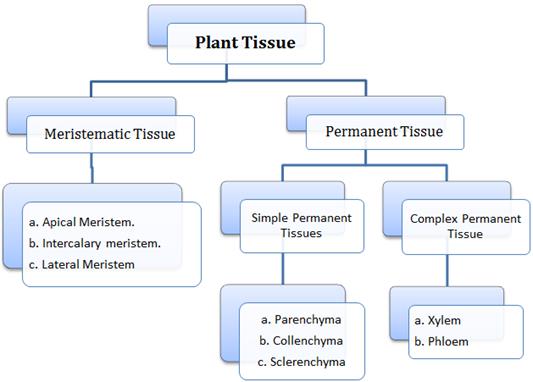
- Meristematic tissue is a simple tissue composed of group of similar and immature cells which can divide and form new cells. The meristem which occurs at tips of roots and shoots are called apical meristem.
- Intercalary meristem occurs between mature tissues especially in grasses.Both apical meristems and intercalary meristems are primary meristems because they appear early in life of a plant and help to form the primary plant body.
- The meristem which occurs on the sides and takes part in increasing girth of the plants are called Lateral meristem. Intrafascicular cambium in the primary lateral meristem. Vascular cambium, cork cambium are secondary meristem.
- The cells that have become structurally and functionally specialized and lose the ability to divide are called permanent tissue. Permanent tissues having all cells similar in structure and function are called simple permanent tissues and those having different kinds of cells are called complex tissue.
- Parenchyma is a simple permanent living tissue which is made up of thin-walled isodiametric cells. Each cell encloses a large central vacuole and peripheral cytoplasm containing nucleus. They are found in non-woody and soft areas of stem, root, leaves, fruits and flowers. They store the food and provide turgidity to softer parts of plant.

- Collenchyma consists of cells which are much thickened at corner due to cellulose, hemicellulose and pectin. Oval, spherical or polygonal often contain chlorophyll. They provide mechanical support to the growing parts of the plants like young stem.
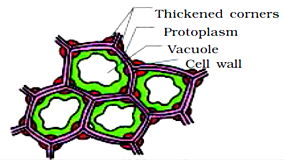
- Sclerenchymas are supportive tissue having highly thick walled cells with little or no protoplasm due to deposition of cellulose or lignin. They are of two types: fibres and sclereids. They provide mechanical support to mature plant organs to tolerate bending, shearing, compression etc.
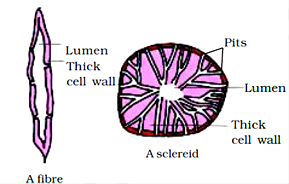
Complex Tissues– Xylem and phloem constitute the complex tissues in plants and work together as a unit.
| Xylem | Phloem |
|
|
- Primary xylem is of two types- protoxylem and metaxylem. In stem, protoxylem lies in centre and metaxylem towards periphery. This type of primary xylem is called endarch.
- In roots, protoxylem lies in periphery and metaxylem lies towards the centre. This type of primary xylem is called exarch.
- In gymnosperms, albuminous cells and sieve cells lack sieve tube and companion cells.

Epidermal Tissue System
- It forms the outermost covering of whole plant body, which consists of epidermal cells, stomata, epidermal appendages (trichomes and hairs).
- Epidermis is single layered, parenchymatous with waxy thick layers of cuticle to prevent water loss.
- Stomata is present in epidermis of leaves. It regulates the transpiration and gaseous exchange. In dicots, stomata are bean-shaped having two guard cells closing the stomatal pore. In monocots, stoma is dumbbell-shaped. Guard cells contain chloroplasts and help in opening and closing of stomata.
- Guard cells are surrounded by subsidiary cells. The stomatal aperture, guard
cells and the surrounding subsidiary cells are together called stomatal apparatus

Dicots (Bean shaped) Monocots (Dumb-bell shaped)
- Epidermis also contains a number of hairs. Root hairs are unicellular elongation of epidermal cells. Trichomes are present on stems, which are multicellular, branched or un-branched preventing water loss due to transpiration.
The ground Tissue System
- All the tissue between epidermis and vascular bundle forms the ground tissues. It consists of simple permanent tissues. Parenchyma is present in pericycle, cortex, pith and medullary rays in stem and roots.
- In leaves the mesophyll, chloroplast containing cell, forms the ground tissues.
The Vascular Tissue System
- The vascular system consists of complex tissues, xylem and phloem that together form vascular bundles.
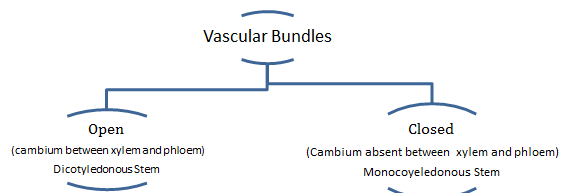
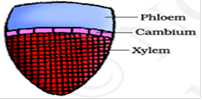
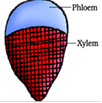
- When xylem and phloem within a vascular bundle are arranged in alternate manner on different radii, the arrangement are called radial as in roots. When xylem and phloem are situated at the same radius of vascular bundle, it is called conjoint as in stem and leaves.
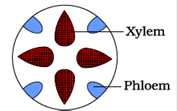
Radial
Dicotyledonous Root
- The outermost layer of dicot root is epidermis containing unicellular root hairs.
- The cortex consists of several layers of thin-walled parenchyma cells.
- The innermost layer of cortex is called endodermis having waxy material suberin as casparian strips, which is impermeable to water.
Monocotyledonous Root
- The anatomy of the monocot root is similar to the dicot root in many respects.
It has epidermis, cortex, endodermis, pericycle, vascular bundles and pith. As
compared to the dicot root which have fewer xylem bundles
Dicotyledonous Stem
- Epidermis: is covered with a thin layer of cuticle and may have Trichomes and stomata.
- Cortex: The cortex is made up of the multiple layers of cells including hypodermis, middle layer of parenchyma cells and innermost layer called endodermis.
- Endodermis cells are rich in starch grains and are called the starch sheath. Pericycle is present on the inner side of endodermis. Layers of radially placed parenchyma between the vascular bundles are called medullary rays.
- A large number of vascular bundles are arranged in a ring. Each vascular bundle is conjoint, open. Protoxylem is endarch
Monocotyledonous Stem
- The hypodermis is made up of sclerenchyma. Vascular bundles are conjoint, closed and scattered. Each vascular bundle is surrounded by a sclerenchymatous bundle sheath.
- Phloem parenchyma is absent. Water-containing cavities are present within the vascular bundles.
Dorsiventral (Dicotyledonous) Leaf
- The leaf lamina of a dorsiventral leaf has 3 parts: epidermis, mesophyll and vascular system.
- The upper epidermis is called adaxial epidermis and lower one is called abaxial epidermis. More number of stomata are present on the abaxial epidermis.
- There are two types of cells in the mesophyll: palisade parenchyma and spongy parenchyma. The palisade parenchyma is placed adaxially.
- The spongy parenchyma is situated below the palisade parenchyma and extends to the lower epidermis. There are numerous large spaces and air cavities between the cells of spongy parenchyma.
- Vascular bundles are surrounded by a layer of thick-walled bundle sheath cells.
Isobilateral (Monocotyledonous) Leaf
- Stomata are present on both the surfaces of an isobilateral leaf. The mesophyll is not differentiated into palisade and spongy parenchyma.
- Some adaxial epidermal cells in grasses are modified into large, empty cells called bulliform cells. When the bulliform cells absorb water, they become turgid. So the leaf surface is exposed. During water stress, when the bulliform cells become flaccid, the leaves curl inwards to minimize water loss.
SECONDARY GROWTH
The increase in girth of a plant body is called secondary growth. The tissues involved in secondary growth are: vascular cambium and cork cambium.
Vascular Cambium:
In case of young stem vascular cambium is present in patches as a single layer between the xylem and phloem. It forms a complete ring at a later stage.
Activity of the Cambial Ring:
- The cambial ring becomes active and begins to cut off new cells, both towards the inner and the outer sides.
- The cells which are cut off towards pith mature into secondary xylem. The cells which are cut off towards periphery mature into secondary phloem.
- The cambium is more active on the inner side than on the outer. As a result, the amount of secondary xylem produced is more than secondary phloem. The primary and secondary phloems get gradually crushed due to the continued formation and accumulation of secondary xylem.
- At some places, the cambium forms a narrow band of parenchyma, which passes through the secondary xylem and the secondary phloem in the radial directions. These are the secondary medullary rays
Spring wood and autumn wood:
- Cambium is very active during the spring season, but less active during the winters. Hence, during spring; a large number of xylem elements are formed having wider vessels. During winter, less xylem elements are formed having narrow vessels.
- The wood formed during summer is called spring wood. The wood formed during winter is called autumn wood.
- The two kinds of wood appear as alternate concentric rings in transverse section of a trunk of a tree. These are called annual rings and provide information about age of the tree.
Heartwood and sapwood:
- In old trees, the greater part of secondary xylem is dark in colour, hard, and resistant to attacks by microorganisms and insect. This region is made of dead elements with highly lignified walls. This wood is called heartwood. The heartwood gives mechanical support but does not conduct water.
- The peripheral part of the secondary xylem is lightly coloured. This is known as sapwood. It helps in conduction of water and minerals.
Cork Cambium
- Mmeristematic tissue which develops in the cortex region is called cork cambium or phellogen.
- The phellogen cuts off cells on both sides. The outer cells differentiate to form cork or phellem while the inner cells differentiate into secondary cortex or phelloderm.
- Phellogen, phellem and phelloderm are collectively called periderm.
- Due to activity of the cork cambium, pressure builds up on the remaining layers peripheral to phellogen. These layers gradually die and fall off.
Lenticels
- At certain regions, the phellogen cuts off closely arranged parenchymatous cells on the outer side instead of cork cells. These parenchymatous cells soon rupture the epidermis, forming a lens-shaped openings called lenticels.
- Lenticels permit the exchange of gases between the outer atmosphere and the internal tissue of the stem.
Secondary Growth in Roots
- The vascular cambium of the dicot root originates from the tissue located just below the phloem bundles. A portion of pericycle tissue present above the protoxylem forms a continuous wavy ring. It gradually becomes circular. Rest of the steps are similar as in dicot stem.
- Secondary growth takes place in stems and roots of gymnosperms. No secondary growth occurs in monocots.
CBSE Class-11 Revision Notes and Key Points
Anatomy of Flowering Plants class 11 Notes Biology. CBSE quick revision note for class-11 Mathematics, Physics, Chemistry, Biology and other subject are very helpful to revise the whole syllabus during exam days. The revision notes covers all important formulas and concepts given in the chapter. Even if you wish to have an overview of a chapter, quick revision notes are here to do if for you. These notes will certainly save your time during stressful exam days.
- Physics
- Chemistry
- Mathematics
- Biology
- Accountancy
- Economics
- Business Studies
- Computer Science
- Informatics Practices
- Geography
To download Anatomy of Flowering Plants class 11 Notes, sample paper for class 11 Chemistry, Physics, Biology, History, Political Science, Economics, Geography, Computer Science, Home Science, Accountancy, Business Studies and Home Science; do check myCBSEguide app or website. myCBSEguide provides sample papers with solution, test papers for chapter-wise practice, NCERT solutions, NCERT Exemplar solutions, quick revision notes for ready reference, CBSE guess papers and CBSE important question papers. Sample Paper all are made available through the best app for CBSE students and myCBSEguide website.
- The Living World class 11 Notes Biology
- Biological Classification class 11 Notes Biology
- Plant Kingdom class 11 Notes Biology
- Animal Kingdom class 11 Notes Biology
- Morphology of Flowering Plants class 11 Notes Biology
- Structural Organisation in Animals class 11 Notes Biology
- Cell Structure and Functions class 11 Notes Biology
- Biomolecules class 11 Notes Biology
- Cell Cycle and Cell Division class 11 Notes Biology
- Transport in Plants class 11 Notes Biology
- Mineral Nutrition class 11 Notes Biology
- Photosynthesis in higher plants class 11 Notes Biology
- Respiration in Plants class 11 Notes Biology
- Plant Growth and Development class 11 Notes Biology
- Digestion And Absorption class 11 Notes Biology
- Breathing and Exchange of Gases class 11 Notes Biology
- Body Fluids And Circulation class 11 Notes Biology
- Excretory Products and their Elimination class 11 Notes Biology
- Locomotion and Movement class 11 Notes Biology
- Neural Control and Coordination class 11 Notes Biology
- Chemical Coordination and Integration class 11 Notes Biology
- Cell Structure and Functions class 11 Notes Biology

Test Generator
Create question paper PDF and online tests with your own name & logo in minutes.
Create Now
Learn8 App
Practice unlimited questions for Entrance tests & government job exams at ₹99 only
Install Now